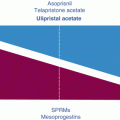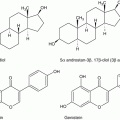Glucose increase
Insulin resistance
Increase in diastolic blood pressure
Hyperlipidemia
Vasoconstriction
Changes in smooth muscle cells of blood vessels
Changes in collagen content
Atrial cardiomyocytes have phenotype partly that of endocrine cells [5]. Polypeptide hormones acting in paracrine/autocrine fashion are C-type natriuretic peptide, adrenomedullin, proadrenomedullin, N terminal peptide, and endothelin 1.
Direct correlation exists between estrogen and lipid levels. Estradiol therapy has favorable effects on lipid levels (Table 23.2).
Table 23.2
Estradiol effects on lipids
Increases hepatic excretion of apolipoproteins |
Decreases transcription of lipoprotein lipase |
Regulates PPARalfa expression |
Decreases adipocyte proliferation |
Decreases PAI, IL-6, CRP, apolipoproteins A, B, D, E, lipoprotein a |
Estradiol therapy can have acute and chronic effects on blood vessels. It acts as calcium antagonist and antioxidant. By decreasing angiotensin II and angioconverting enzyme, estrogen therapy dilatates blood vessels by decreasing vasoconstriction induced by acetilholin. Positive effects of estrogens on cardiovascular system are shown in Table 23.3.
Table 23.3
Positive effects of estrogen therapy
Interaction with renin-angiotensin-aldosterone system |
Interaction with autonomous nervous system |
Anti-inflammatory effects |
Vasodilatation |
Decrease of vascular and myocardial hypertrophy |
Decrease of endothelin 1 |
Hypertension is the cause of deaths in 62 % subjects with cardiovascular insults and 49 % with ischemic heart disease. The main cause of plaque instability is the rupture of fissure. Hypertension directly induces cerebral hemorrhage and leads to renal disease.
Kannel [6] found that 27 % of women and 37 % of men have hypertension. Highly normal blood pressure (130–139/85–89 mmHg) induces twice higher risk for cardiovascular disease. Of all women with hypertension, 37.8 % develop it in menopause. Only 10 mmHg decrease of blood pressure decreases insult 30 % and myocardial infarction 23 % [7]. In a sample of 56 million subjects, the World Health Organization found in 1999 that hypertension causes 38 % of all deaths.
Factors increasing blood pressure in the menopause are increased sympathetic activity, oxidative stress, abdominal obesity, hyperinsulinism, and reduced arterial elasticity. Lack of estradiol diminishes the elasticity of arteries during 5–20 years [8].
Hypoestrogenia increases inflammatory cytokines, prostaglandins, plasminogen activator inhibitor (PAI) inducing necrosis, inflamed cell infiltrate, fibrosis, pathological tissue remodeling, and organ dysfunction.
The increase of blood pressure is mainly due to a shift of the autonomic control of the autonomous nervous system towards a prevalence of sympathetic tone together with a greater activity of renin-angiotensin-aldosterone system. Deleterious effects of hyperaldosteronism are shown in Table 23.4. In such a situation, hypertension develops with the following consequences: heart remodeling, left ventricle fibrosis, kidney nephrosclerosis, and arteriole remodeling.
Table 23.4
Deleterious effects of hyperaldosteronism
Prothrombotic activity |
Hypertension |
Endothelial dysfunction |
Autonomous nervous system dysfunction |
Potassium loss |
Natrium retention |
Ventricular arrhythmias |
Myocardial fibrosis and necrosis |
Hypoestrogenia induces insulin resistance, hyperinsulinemia, natrium retention, and hypertension [9]. Estrogen therapy increases natrium excretion and prevents edema (Table 23.5).
Table 23.5
Effects of estrogen induced natrium excretion
Better baroreceptor function |
Vascular fibrosis prevention |
Better diastolic function |
Decreasing hypertension |
Decreasing ectopic activity from ventricles |
Decreasing PAI |
Decreasing mortality rate from cardiac insufficiency |
According to all previously mentioned, estroprogestagen therapy during climacterium is necessary in order to prevent cardiovascular diseases, achieving longer life expectancy and better quality of life.
23.2 Gender-Specific Hypertension in Men with Involutive Hypoandrogenism
Involutive hypoandrogenism is defined by the presence of typical symptoms in aging male and testosterone levels below 11 nM/L (Endocrine Society Consensus). From the age of 40 years, testosterone levels decline about 1 % per year leading to decreased vitality, lower energy, erectile dysfunction, lower muscle mass strength, decreased bone density, depression, irritability, increased abdominal adipose tissue, insomnia, loss of concentration, etc.
Stay updated, free articles. Join our Telegram channel

Full access? Get Clinical Tree





